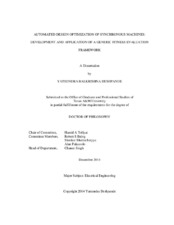| dc.contributor.advisor | Toliyat, Hamid A | |
| dc.creator | Deshpande, Yateendra Balkrishna | |
| dc.date.accessioned | 2015-04-28T15:35:31Z | |
| dc.date.available | 2016-12-01T06:36:04Z | |
| dc.date.created | 2014-12 | |
| dc.date.issued | 2014-12-15 | |
| dc.date.submitted | December 2014 | |
| dc.identifier.uri | https://hdl.handle.net/1969.1/154134 | |
| dc.description.abstract | A rotating synchronous electric machine design can be described to its entirety by a combination of 17 to 24 discrete and continuous parameters pertaining the geometry, material selection, and electrical loading. Determining the performance attributes of a design often involves numerical solutions to thermal and magnetic equations. Stochastic optimization methods have proven effective for solving specific design problems in literature. A major challenge to design automation, however, is whether the design tool is versatile enough to solve design problems with different types of objectives and requirements.
This work proposes a black-box approach in an attempt to encompass a wide variety of synchronous machine design problems. This approach attempts to enlist all possible attributes of interest (AoIs) to the end-user so that the design optimization problem can be framed by combination of such attributes only. The number of ways the end-user can input requirements is now defined and limited. Design problems are classified based on which of the AoI’s are constraints, objectives or design parameters. It is observed that regardless of the optimization problem definition, the evaluation of any design is based on a common set of physical and analytical models and empirical data. Problem definitions are derived based on black-box approach and efficient fitness evaluation algorithms are tailored to meet requirements of each problem definition.
The proposed framework is implemented in Matlab/C++ environment encompassing different aspects of motor design. The framework is employed for designing synchronous machines for three applications where designs based on conventional motor construction did not meet all design requirements. The first design problem is to develop a novel bar-conductor tooth-wound stator technology for 1.2 kW in-wheel direct drive motor for an electric/hybrid-electric two wheeler (including practical implementation). The second design problem deals with a novel outer-rotor buried ferrite magnet geometry for a 1.2 kW in-wheel geared motor drive used in an electric/hybrid-electric two wheeler (including practical implementation). The third application involves design of an ultra-cost-effective and ultra-light-weight 1 kW aluminum conductor motor.
Thus, the efficacy of automated design is demonstrated by harnessing the framework and algorithms for exploring new technologies applicable for three distinct design problems originated from practical applications. | en |
| dc.format.mimetype | application/pdf | |
| dc.language.iso | en | |
| dc.subject | Electrical machines | en |
| dc.subject | Automated design | en |
| dc.subject | optimization | en |
| dc.subject | permanent magnet synchronous machines | en |
| dc.title | Automated Design Optimization of Synchronous Machines: Development and Application of a Generic Fitness Evaluation Framework | en |
| dc.type | Thesis | en |
| thesis.degree.department | Electrical and Computer Engineering | en |
| thesis.degree.discipline | Electrical Engineering | en |
| thesis.degree.grantor | Texas A & M University | en |
| thesis.degree.name | Doctor of Philosophy | en |
| thesis.degree.level | Doctoral | en |
| dc.contributor.committeeMember | Balog, Robert S | |
| dc.contributor.committeeMember | Bhattacharyya, Shankar P | |
| dc.contributor.committeeMember | Palazzolo, Alan | |
| dc.type.material | text | en |
| dc.date.updated | 2015-04-28T15:35:31Z | |
| local.embargo.terms | 2016-12-01 | |
| local.etdauthor.orcid | 0000-0002-3358-807X | |


